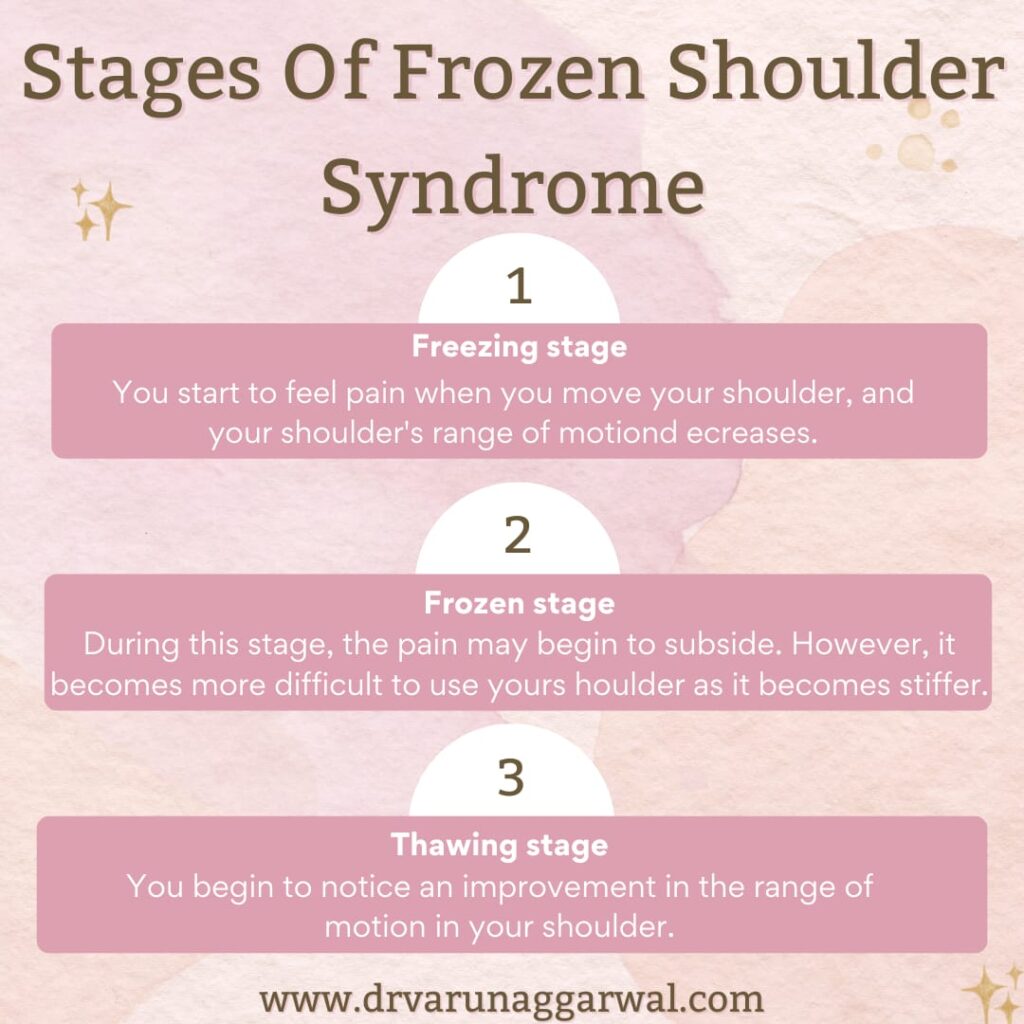Frozen shoulder is a disorder that affects the joint of your shoulder. As the condition progresses, it usually becomes more painful and stiffer, then finally disappears. The process can take from one year to three years.
It most typically affects persons between the ages of 40 and60, and it affects women more than men. It is expected to impact roughly 3 percent of people.
It occurs when the capsule that surrounds the normal shoulder joint becomes inflamed, thickened, scarred, and shrinks. Any shoulder injury may result in a frozen shoulder due to the shoulder capsule’s subsequent scarring. Injuries such as bursitis, tendinitis, and rotator cuff tears can result in a frozen shoulder.
Frozen shoulders occur more frequently in people with chronic inflammatory arthritis of the shoulder, diabetes, or after breast or chest surgery. Long-term immobilization of the shoulder joint can put patients at risk to develop a frozen shoulder.

Stages Of Frozen Shoulder Syndrome
Frozen shoulder has three stages, and it usually develops slowly. Each stage may take several months to complete.
Freezing stage.
You start to feel pain when you move your shoulder, and your shoulder’s range of motion decreases.
Frozen stage.
During this stage, the pain may begin to subside. However, it becomes more difficult to use your shoulder as it becomes stiffer.
Thawing stage.
You begin to notice an improvement in the range of motion in your shoulder.
Easy Ways To Avoid Getting Frozen Shoulder
It is crucial to take precautions to avoid Frozen shoulder syndrome because the recovery process is long and difficult. To help prevent it, here are a few simple ways:
- Stretch your back and shoulder muscles daily.
- Start doing multiple motion exercises as early as possible after an injury.
- Rotate your hands and palms to stretch different tendons.
- When sitting at a desk and using a computer, practice good ergonomics.
- If you have diabetes, you must keep a tight eye on it.
- Keeping your immune system in Healthy condition.
Treatment
The majority of frozen shoulder treatment focuses on reducing shoulder pain and keeping as much shoulder range of motion as feasible.
Therapy
You can learn range-of-motion exercises from a physical therapist to help your shoulder regain as much movement as possible. Your dedication to performing these workouts is crucial for maximising your mobility recovery.
Medications
Over-the-counter pain medications, such as aspirin and ibuprofen, can help reduce the pain and swelling associated with a frozen shoulder. In some circumstances, your doctor may recommend stronger pain relievers and anti-inflammatory medications.
Surgical and other procedures
In most cases, it takes 12 to 18 months for frozen shoulders to resolve on their own. Your doctor might advise the following if your symptoms persist:
Steroid injections
Injecting corticosteroids into your shoulder joint may help reduce pain and increase mobility, particularly in the early stages of the condition.
Shoulder manipulation
A general anaesthetic will keep you unconscious and pain-free during this procedure. Your doctor will then move your shoulder joint in different directions to help loosen the tightened tissue.
Joint distension
Sterile water can be injected into the joint capsule to stretch the tissue and facilitate joint movement.
Surgery
Surgery to treat frozen shoulder is uncommon, but if all other treatments have failed, your doctor might advise surgery to remove adhesions and scar tissue from inside your shoulder joint. Typically, doctors use tiny incisions around your joint to insert lighted, tubular instruments during this surgery (arthroscopically).


